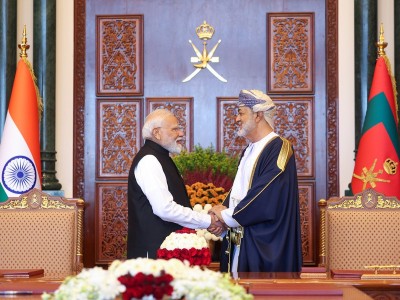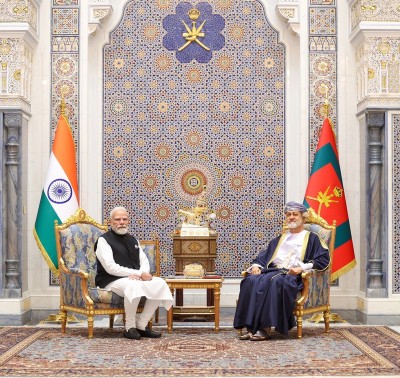 Pakistan Hindu Temple
Pakistan Hindu Temple
Fate of ancient Hindu temple in Peshawar tells a tale
On 10 February 2023, the Peshawar High Court expressed its displeasure that after more than three years, the issue of the Panj Tirath, a place of pilgrimage and prayer for Hindus in Pakistan had not been solved and hinted that corruption among local officials was the main reason for the delay in settling the issue.
The plight of the Hindus in Pakistan is well-known, but lesser known is the situation of their places of worship, one such holy place being the ancient religious site in Peshawar which was declared as a national heritage site in 2019.
There are numerous ways of desecrating sacred religious sites but using them as warehouses in an amusement park may well be one of the worst.
This is what has happened to Panj Tirath, once a flourishing Hindu pilgrimage site in Peshawar, the capital of Khyber Pakhtunkhwa province in Pakistan.
A survey carried out by All Pakistan Hindu Rights Movement reveals that out of 428 Hindu temples in Pakistan that existed before Partition, only around 20 survive today and most of them remain neglected.
Controlled by the Evacuee Trust Property Board, many temples today have been converted for other uses.
Many active and former Hindu temples were attacked in the 1992 riots and in other attacks, like the 2014 Larkana temple attack, 2019 Ghotki riots, and the 2020 Karak temple attack.
The case of Panj Tirath is thus another example of many temples in Pakistan which lie in disuse.
The declaration by the provincial government of Khyber Pakhtunkhwa of Panj Tirathas a national heritage site was, however, the beginning rather than the end of a legal battle.
The amusement park owners, who use the temple as warehouses, told the Provincial Government that it was ready to give back one kanal (0.125 acre) and 11 marlas of the site, while archaeologists claim it consists of 5 kanals (0.625 acre) and 11 marlas (0.06 acre), which is almost six times more.
The story became worse when archaeologists tried to access the site and were intimidated by armed men.
In 2019, the KPK provincial government had announced a fine of up to Rs 2 million and, five years’ imprisonment, for anyone found guilty of damaging the site.
The Archaeology Directorate asked the Khyber Pakhtunkhwa government to clear the site of encroachment and allow archaeologists to carry out much-needed preservation work. It also asked for the construction of a boundary wall around the site.
Reports from 2019 indicate that the historical structure, with two temples and a gateway, is in a dilapidated condition and in urgent need of archaeological conservation.
Most of its ground is covered by a family park, while the buildings are being used as godowns by the park owner.
According to the government record, the total area covered by Panj Tirath is about 14 kanals and seven marlas.
Nawazuddin, an archaeologist associated with the local Directorate of Archaeology and Museums is reported to have said,“The contractor of Chacha Younas Park is not taking good care of the ancient buildings and is using them for storage of useless items.”
The archaeologist added most of the original components and designs had been removed or damaged.
“A building that existed till 2012 was demolished by the park management,” he said.
Besides the two temples, there is a hollow structure which is also on the verge of collapse and occupied by a tenant of the Auqaf Department since 1960.
Archaeologists say that they are not permitted to go inside the park to examine the site by the security guards of the Chacha Younas Park.
A survey of literature that traces the history of this site makes for interesting reading. Archaeologist S.M.Jaffar in his book“An Introduction to Peshawar”, published in 1952, wrote, “The Panj-Tirath (five tanks) is among the places of interest and antiquity in or around Peshawar, dating back to the Buddhist times. Archaeologists also believe Panj Tirath holds marks of the Buddha’s Begging Bowl.”
The English archaeologist Sir Alexander Cunningham and French archaeologist Alfred Foucher had also identified the site with the place of Buddha’s Alam Bowl. Munshi Gopal Das, the author of Tareekh-e-Peshawar published in 1874, traces its origin to the five sons of Pandu.
Nawazuddin said Hindus used to come to bathe during festivals and in the month of Kartik (between 23 October and 21 November).
He said celebrations were held under the trees for two days.After Partition in 1947, only two dilapidated temples survived, and the area became part of a lease from the local government to the company operating the Chacha Younas Family Park.
Both temples are inside the park and a gateway leading to the temple complex is outside the park. The temples stand a few metres away from each other.
The gateway is occupied by a tenant of the Evacuee Trust Property Board, Alam Khan.
He, too, does not permit archaeologists to enter the place. Khan says his family had been living there since the 1960s.One description of the temple in The Friday Times (15 February 2019) states that the western temple, had an arched entrance on the east side which opened on to a pillared outdoor hall with three arches and a vaulted ceiling. Many of its decorative designs have been badly damaged.
Small bricks – locally known as Waziri bricks – were used in the construction of both temples at Pancha Tirtha. They were set in lime mortar and plastered.
The style of construction and decorative scheme, arched panels, slender plasters of the dvarashakhas, a ribbed dome, miniature niches and decorative half-dome wrought in stucco at the apex of arched panels on the northern wall – and other features of the western temple are comparable to the late-nineteenth century.In the eastern temple, there were spaces for placing deities/sculptures for worship.
The dome was decorated but is now in a terrible condition.The gateway or the entrance of the temple complex had a cusped arch entrance on the east side which opens into a small mandapa with three arched openings. There are two rooms on each side of the gateway with a veranda in the front.
The utter neglect of Panj Tirath in Peshawar is a classic example of how the Pakistani state has turned Hindu temples into places of common use.
Legal issues apart, the root cause of such neglect stems from the manifold focus of the state in protecting extreme aspects of Islam, to the complete marginalisation of minority rights.
It is this blatant disregard for the human rights of minorities, including Hindus, which has created this situation in Pakistan. Beyond the technical and legal issues, the Panj Tirathcase offers further evidence of the disrespect in which the historical heritage of Hinduism is often held in Pakistan.
Support Our Journalism
We cannot do without you.. your contribution supports unbiased journalism
IBNS is not driven by any ism- not wokeism, not racism, not skewed secularism, not hyper right-wing or left liberal ideals, nor by any hardline religious beliefs or hyper nationalism. We want to serve you good old objective news, as they are. We do not judge or preach. We let people decide for themselves. We only try to present factual and well-sourced news.






